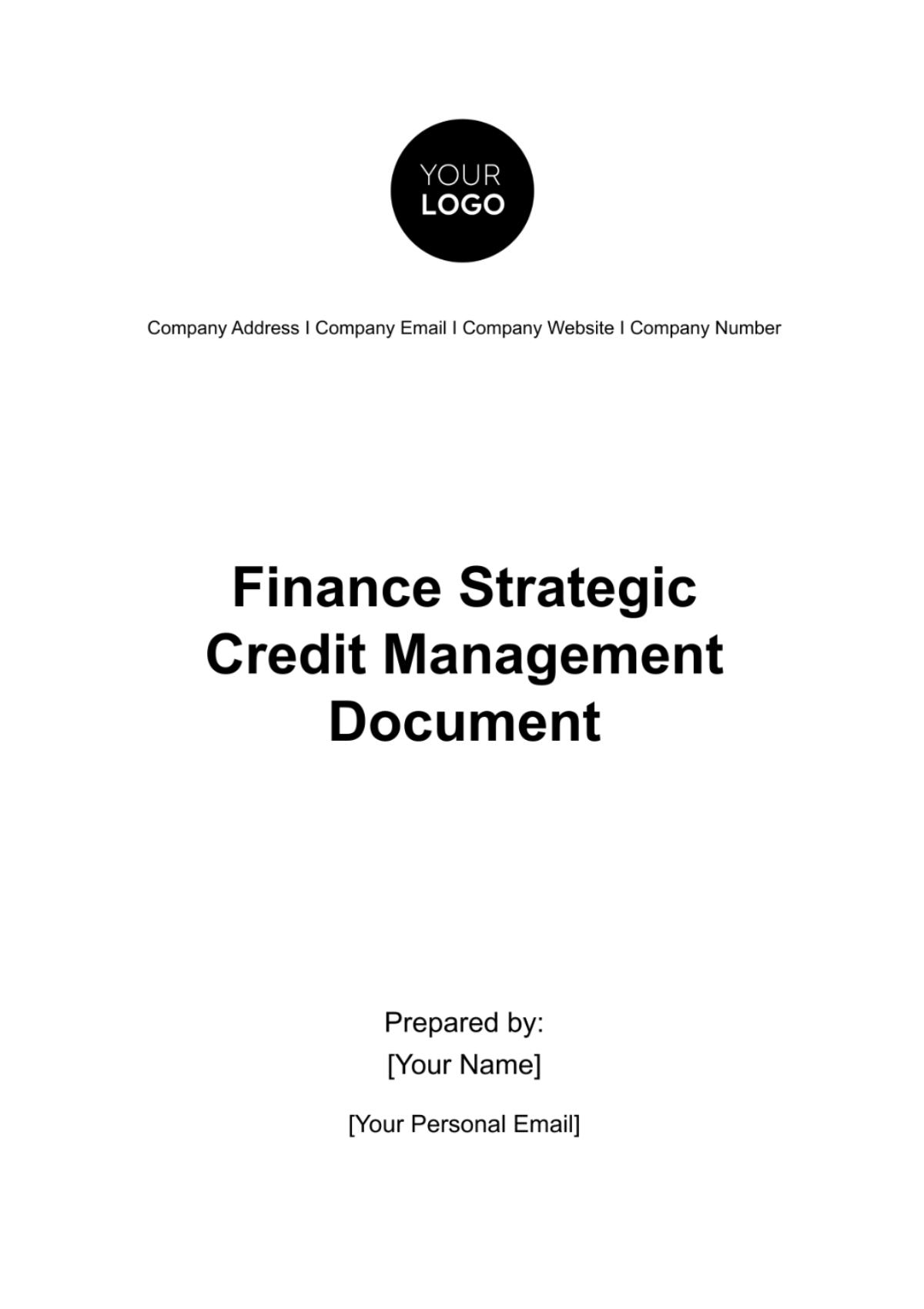Free Finance Strategic Credit Management Document

Credit Policy and Strategy
We delineate our company's comprehensive Credit Policy and Strategy in this section, setting the foundation for prudent and effective credit management. It encapsulates our approach to credit risk, outlines our risk appetite, and defines the objectives of our credit management function, ensuring alignment with both business goals and regulatory requirements.
Overview of Credit Management Philosophy
Our company's credit management philosophy is rooted in a balanced approach towards risk and opportunity. We aim to optimize our credit portfolio, ensuring sustainable growth while maintaining a conservative stance on risk exposure. This philosophy guides all credit-related decisions and practices.
Risk Appetite Statement
The company's risk appetite is defined by our commitment to maintaining a strong and diversified credit portfolio. We target a risk profile that supports our strategic objectives while ensuring compliance with regulatory standards and internal risk thresholds. Our appetite includes a focus on high-quality credit exposures and a cautious approach towards high-risk segments.
Strategic Objectives of Credit Management
Risk Mitigation: Implement robust risk assessment and mitigation strategies to minimize defaults and bad debts.
Portfolio Diversification: Diversify credit exposures across various industries and borrower segments to spread risk.
Compliance and Regulatory Adherence: Ensure strict compliance with U.S. financial regulations, including the Dodd-Frank Act and the Fair Credit Reporting Act.
Operational Efficiency: Streamline credit management processes to enhance operational efficiency and customer satisfaction.
Financial Stability: Aim for financial stability by maintaining an optimal balance between credit growth and quality.
Implementation of Credit Strategy
Our credit strategy is implemented through a comprehensive framework encompassing credit approval, monitoring, and reporting processes. This ensures alignment with our overarching business goals and the dynamic nature of the financial markets.
Risk Assessment and Credit Scoring
In our Risk Assessment and Credit Scoring section, we elaborate on the sophisticated methodologies employed to accurately gauge the credit risk associated with each borrower. This process is integral to our credit management strategy, utilizing advanced credit scoring models and a range of risk assessment tools to ensure a comprehensive evaluation.
Risk Assessment Component | Description |
Credit Scoring Models | Utilize advanced models incorporating credit history, debt levels, repayment history, income stability to generate a quantifiable credit score. |
Financial Analysis | In-depth examination of liquidity, profitability, leverage, and cash flow stability to assess financial health. |
Market and Industry Analysis | Analysis of market trends and industry-specific risks, including economic indicators, industry health, and market competition. |
Behavioral Analysis | Evaluation of payment patterns, account usage, and financial discipline to understand the borrower's credit management skills. |
External Credit Reports | Use of reports from recognized credit bureaus for a comprehensive view of the borrower's credit history across different lenders and credit types. |
Stress Testing and Sensitivity Analysis | Testing scenarios under various economic conditions to predict the impact of market changes or shifts in the borrower's financial situation on their creditworthiness. |
Credit Limits and Terms
In the Credit Limits and Terms section, we define the structured approach to setting credit limits and terms for different categories of borrowers. This framework ensures responsible lending by specifying maximum credit amounts and tailored terms, such as payment periods and interest rates, which are aligned with the borrower's creditworthiness and risk profile.
Borrower Category | Maximum Credit Limit | Payment Period | Interest Rate |
Small Businesses | Up to $50,000 | Short-term (up to 12 months) | 7-10%, variable, risk-based |
Medium Enterprises | Up to $200,000 | Medium-term (1-3 years) | 5-7%, fixed or variable |
Large Corporations | Up to $2 million | Long-term (3-5 years) | 3-5%, lower fixed rate |
Individual Consumers | Up to $25,000 | Varies (6-24 months) | 8-12%, higher variable rate |
High-Risk Borrowers | Up to $10,000 | Short-term, strict terms | 12-15%, higher risk premium |
Monitoring and Reporting
In this Monitoring and Reporting section, we present a structured framework designed to ensure diligent oversight of our credit exposures. This involves continuous monitoring, regular reviews, comprehensive reporting systems, stress testing, and quality audits. The process is tailored to identify risks proactively, adhere to compliance standards, and maintain the health of our credit portfolio.
Component | Objective | Methods/Tools | Frequency |
Continuous Credit Monitoring | Assess creditworthiness and identify changes in risk profiles. | Real-time data analytics, monitoring tools. | Daily for high-risk, weekly/monthly for others. |
Regular Credit Reviews | In-depth evaluation of credit exposures. | Financial reviews, account analysis. | Quarterly, monthly for high-risk categories. |
Reporting Systems | Provide insights and ensure policy compliance. | Credit exposure, exception, and compliance reports. | As per internal policy and regulatory needs. |
Stress Testing and Scenario Analysis | Assess impact of economic scenarios on credit portfolio. | Scenario analysis and stress testing models. | Semi-annually or as market conditions dictate. |
Audit and Quality Control | Validate monitoring and reporting system effectiveness. | Internal and external audits. | Annually, with interim audits as necessary. |
Compliance and Regulatory Requirements
Our credit management practices are meticulously aligned with key financial regulations to ensure legal compliance and uphold industry standards. We rigorously adhere to the Dodd-Frank Wall Street Reform and Consumer Protection Act, which mandates comprehensive financial reforms to prevent systemic risk. Additionally, compliance with the Fair Credit Reporting Act ensures accurate and fair credit reporting. We also rigorously follow the Equal Credit Opportunity Act to prevent discrimination in credit issuance.
Internal Compliance Procedures
To reinforce our commitment to regulatory compliance, we have established robust internal compliance procedures. These include regular training programs for staff on regulatory changes, internal audits to assess compliance with both internal policies and external regulations, and a dedicated compliance team responsible for overseeing all credit management activities. This internal framework not only safeguards us against legal risks but also reinforces ethical lending practices.
Portfolio Management
In our Portfolio Management section, we outline strategic approaches for managing the credit portfolio effectively. This includes diversification strategies to mitigate risk, setting concentration limits to avoid overexposure, and employing risk-adjusted return methodologies. These measures are essential for maintaining a balanced and resilient credit portfolio, aligned with our overall financial objectives.
Aspect | Objective | Approach/ Methodology | Monitoring/Review |
Diversification Strategy | Spread credit risk across sectors and borrowers. | Allocate exposures among industries, geographies, borrower segments. | Regular review and adjustment based on market trends. |
Concentration Limits | Prevent excessive exposure to single entities. | Set caps on credit extended to individual borrowers or connected groups. | Continuous monitoring, realignment if thresholds exceeded. |
Internal Controls and Audit
Our Internal Controls and Audit framework is meticulously structured to guarantee the integrity and effectiveness of the credit management process. This comprehensive system safeguards against risks, ensures compliance with policies, and maintains operational excellence.
Internal Controls
Risk Management Controls: Implement controls to identify, assess, and mitigate credit risks.
Operational Controls: Establish procedures for transaction processing, documentation, and data management to ensure accuracy and efficiency.
Compliance Controls: Enforce adherence to internal policies and external regulatory requirements, with periodic reviews for updates in regulations.
Audit Procedures
Regular Internal Audits: Conduct thorough internal audits to evaluate the effectiveness of internal controls and identify areas for improvement.
External Audits: Engage independent external auditors to validate the internal audit findings and provide an objective assessment.
Continuous Monitoring and Reporting: Utilize continuous monitoring systems to detect any deviations from set controls, with immediate reporting and rectification measures.
Training and Development
Our Training and Development program is meticulously crafted to ensure that our staff involved in credit management are well-equipped with the necessary skills and knowledge. This program is integral to maintaining the highest standards of professional competence and service quality.
Comprehensive Training Modules
Foundational Training: Initial training covering basic credit principles, company policies, and regulatory compliance requirements.
Advanced Credit Analysis: Specialized modules on risk assessment, financial analysis, and portfolio management.
Regulatory Compliance Updates: Regular updates on evolving financial regulations and compliance standards.
Soft Skills Development: Training on customer relations, negotiation techniques, and effective communication.
Ongoing Development Initiatives
Continuous Learning Opportunities: Access to seminars, webinars, and industry conferences.
In-House Workshops: Regularly scheduled workshops conducted by internal or external experts on emerging trends and best practices in credit management.
Performance-Based Learning Paths: Tailored development plans based on individual performance reviews and career progression goals.
- 100% Customizable, free editor
- Access 1 Million+ Templates, photo’s & graphics
- Download or share as a template
- Click and replace photos, graphics, text, backgrounds
- Resize, crop, AI write & more
- Access advanced editor
Unlock financial prowess with the Finance Strategic Credit Management Document Template from Template.net. This editable and customizable template, powered by an advanced AI editor tool, streamlines credit management. Craft tailored credit policies, assess risks and optimize collections effortlessly. Elevate your financial strategy with this dynamic template, ensuring resilience in an ever-changing market.





























